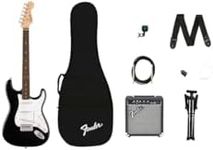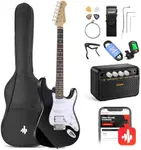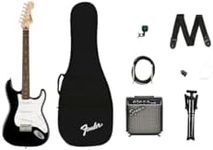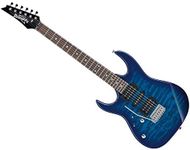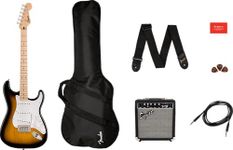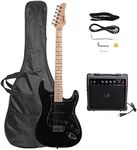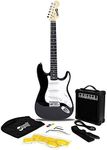Buying Guide for the Best Beginner Electric Guitars
Choosing your first electric guitar can be an exciting yet overwhelming experience. With so many options available, it's important to understand the key specifications that will impact your playing experience. By focusing on these specs, you can find a guitar that suits your needs and helps you enjoy your musical journey.Body TypeThe body type of an electric guitar affects its sound and comfort. Solid body guitars are the most common and versatile, offering a wide range of tones suitable for various music styles. Hollow and semi-hollow body guitars provide a warmer, more resonant sound, often preferred for jazz and blues. Consider the type of music you want to play and choose a body type that complements it.
Neck ProfileThe neck profile refers to the shape and thickness of the guitar neck. Common profiles include C-shaped, U-shaped, and V-shaped. A C-shaped neck is generally comfortable for most players, while U-shaped and V-shaped necks may offer more support for larger hands. Try different neck profiles to see which feels most comfortable for your hand size and playing style.
Scale LengthScale length is the distance between the nut and the bridge of the guitar. It affects the tension of the strings and the overall feel of the instrument. Shorter scale lengths (around 24.75 inches) are easier to play and bend strings, making them ideal for beginners. Longer scale lengths (around 25.5 inches) provide a tighter feel and are often preferred for genres like rock and metal. Choose a scale length that feels comfortable and suits your musical preferences.
PickupsPickups are the devices that capture the sound of the strings and convert it into an electrical signal. Single-coil pickups offer a bright, clear tone, while humbuckers provide a thicker, warmer sound with less noise. Some guitars come with a combination of both. Consider the type of music you want to play and choose pickups that match the desired sound.
Bridge TypeThe bridge type affects the guitar's tuning stability and ease of string changes. Fixed bridges are simple and reliable, making them a good choice for beginners. Tremolo bridges allow for pitch bending effects but can be more challenging to maintain. If you're just starting out, a fixed bridge may be the best option for ease of use.
Wood TypeThe type of wood used in the guitar's construction can influence its tone and weight. Common woods include alder, basswood, mahogany, and maple. Alder and basswood are lightweight and provide a balanced tone, making them suitable for beginners. Mahogany offers a warmer sound, while maple provides brightness and sustain. Choose a wood type that complements the sound you want to achieve.
Fretboard MaterialThe material of the fretboard can affect the feel and playability of the guitar. Common materials include rosewood, maple, and ebony. Rosewood offers a smooth feel and warm tone, while maple provides a brighter sound and a slick surface. Ebony is known for its durability and smoothness. Try different fretboard materials to see which feels best under your fingers.
